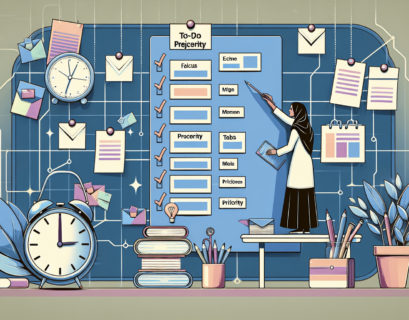Are you a freelancer who struggles with keeping track of tasks and staying organized? Look no further! In this article, we will show you how to create a task management system that is tailored to your needs and helps you stay productive. Whether you are juggling multiple clients or working on various projects, having a reliable system in place is essential. By following these simple steps, you can create a task management system that works for you as a freelancer, allowing you to stay on top of deadlines and achieve your goals with ease. So let’s get started and take control of your workload!
Understanding the Need for a Task Management System
As a freelancer, managing your tasks and staying organized is crucial for your success. This is where a task management system comes into play. A task management system is a tool or software that helps you keep track of your tasks, deadlines, and priorities in one centralized location. It allows you to streamline your workflow, increase productivity, and effectively manage your time.
Explanation of a task management system
A task management system essentially provides you with a platform to create, organize, and track all your tasks in one place. It allows you to break down your projects into smaller tasks and set deadlines for each one. With a task management system, you can easily prioritize your tasks, assign them to specific projects or clients, and track their progress.
Benefits of a task management system for freelancers
Using a task management system can offer several benefits to freelancers. Firstly, it helps you stay organized and ensures that you never miss a deadline. By having all your tasks in one place, you can easily see what needs to be done and when. This saves you time and reduces stress.
Secondly, a task management system allows you to prioritize your tasks effectively. You can categorize your tasks based on their importance and urgency, ensuring that you focus on the most critical ones first. This helps you optimize your time and resources and ensures that you deliver high-quality work on time.
Additionally, a task management system enables you to track your progress and maintain transparency with your clients. You can easily provide updates on the status of your tasks and share progress reports. This helps build trust and strengthens your professional relationships.
Issues that a task management system can resolve
Freelancers often face challenges such as a lack of organization, difficulty in prioritizing tasks, and poor time management. These issues can lead to missed deadlines, decreased productivity, and increased stress levels. However, a task management system can resolve these issues by providing a structured approach to task management.
A task management system helps freelancers overcome disorganization by centralizing all their tasks in one place. It provides a clear overview of what needs to be done and when, eliminating the risk of forgetting or overlooking important tasks.
Furthermore, a task management system assists in prioritizing tasks effectively. By categorizing tasks based on their importance and urgency, freelancers can allocate their time and resources efficiently. This ensures that important tasks are not neglected and deadlines are met consistently.
Lastly, a task management system promotes better time management. Freelancers can allocate specific time slots for tasks and create a schedule that optimizes their productivity. This reduces the likelihood of spending excessive time on non-essential tasks and helps maintain a healthy work-life balance.
Different Types of Task Management Systems
When it comes to task management systems, there are various options available for freelancers to choose from. Each system has its own unique features and advantages. Let’s explore some of the popular task management systems and delve into what makes them stand out.
Listing and describing various systems available
Kanban Boards: Kanban boards are a visual task management system that uses cards and columns to represent tasks and their progress. This system allows freelancers to easily move tasks from one column to another, indicating their current status.
To-Do Lists: To-do lists are simple yet effective task management systems that allow freelancers to list their tasks in order of priority. Tasks can be easily checked off or marked as complete once finished.
Time Tracking Tools: Time tracking tools not only help freelancers manage their tasks but also track the time spent on each task. This allows for accurate billing and provides insights into productivity levels.
Project Management Software: Project management software offers a comprehensive solution for freelancers by combining task management, team collaboration, and project planning features. These tools often come with advanced functionalities, such as Gantt charts and resource allocation.
Outline features and advantages for each system
Kanban Boards: Kanban boards provide a visual representation of tasks, making it easy to track progress. They promote collaboration and allow for real-time updates. Kanban boards are particularly useful for managing agile projects and workflows.
To-Do Lists: To-do lists are simple and intuitive, allowing freelancers to quickly jot down tasks as they come to mind. They provide a clear overview of what needs to be done and can be easily customized based on priorities and deadlines.
Time Tracking Tools: Time tracking tools help freelancers stay accountable and ensure accurate billing for their work. They provide insights into productivity levels and can help identify areas for improvement.
Project Management Software: Project management software offers a robust set of features, including task management, collaboration tools, and project planning capabilities. They provide a comprehensive solution for freelancers working on complex projects or collaborating with a team.
Choosing the right system based on your needs
Selecting the most suitable task management system depends on your specific needs and preferences as a freelancer. Consider factors such as the complexity of your projects, the need for collaboration, and the level of customization required. It may be helpful to start with a simpler system, such as a to-do list, and gradually transition to more advanced systems as your needs evolve.
Remember to assess the scalability and accessibility of the system, as you may want a solution that can grow with your business and is accessible across multiple devices. Take advantage of free trials or demos offered by the different task management systems to find the best fit for your workflow.
Getting Started with Your Task Management System
Now that you understand the importance of a task management system and have explored the different types available, let’s delve into how you can get started with implementing one for your freelancing business.
Establishing goals and objectives
Before diving into the task management system, it’s crucial to establish clear goals and objectives for your freelancing business. Determine what you want to achieve and break it down into actionable tasks. This will provide a roadmap to guide your task management system implementation.
Defining tasks and subtasks
Once you have your goals defined, start breaking them down into smaller tasks and subtasks. This helps you create a clear action plan and ensures that no task is overlooked. Remember to be specific in defining each task, including any dependencies or milestones associated with it.
Setting deadlines and priorities
Assign deadlines and priorities to your tasks to ensure efficient time management. Deadlines help you stay on track and complete tasks in a timely manner, while priorities allow you to focus on the most important tasks first. Use your task management system to set due dates and prioritize tasks accordingly.
Incorporating Advanced Features
While the basic functionalities of a task management system are essential, exploring and utilizing advanced features can further enhance your productivity and efficiency as a freelancer.
Adding tags and labels
Tags and labels are useful organizational tools that allow you to categorize and filter your tasks based on specific criteria. Assign relevant tags or labels to your tasks to easily locate and prioritize them. For example, you can use tags to identify tasks related to specific clients or projects.
Creating custom filters
Custom filters enable you to narrow down your task list based on specific criteria. This helps in focusing on important tasks or tasks that require immediate attention. Set up filters to view tasks based on deadlines, priorities, or any other customized criteria that align with your workflow.
Setting up reminders and notifications
Reminders and notifications can be set within your task management system to ensure you never miss important deadlines or updates. These features help you stay on top of your tasks and provide timely prompts for upcoming deadlines. Customize your preferences for notifications to align them with your working habits and preferences.
Customizing Your Task Management System
To make your task management system truly personalized and tailored to your specific needs, consider customizing its appearance, workflow, and functionality.
Personalizing your system’s appearance
Many task management systems offer options to customize the appearance, such as choosing different themes or color schemes. Personalize your system’s appearance to create a visually pleasing and motivating workspace that reflects your personal style.
Customizing your workflow
Adapt your task management system to match your preferred workflow. Some systems allow you to customize the layout and structure of your task lists, enabling you to organize tasks in a way that aligns with your work process. Experiment with different configurations and find what works best for you.
Adding necessary widgets and plugins
If your task management system supports it, consider adding widgets or plugins that enhance its functionality. These additional tools can provide integrations with other apps, create shortcuts for commonly performed actions, or display relevant information, streamlining your workflow.
Integrating Your Task Management System with Other Tools
To maximize the efficiency of your task management system, consider integrating it with other tools and applications that are essential to your freelance work.
Syncing with calendar apps and email
Syncing your task management system with calendar apps and email allows for seamless integration of your tasks and deadlines with your overall schedule. This ensures that you have a holistic view of your commitments and helps in efficient time management.
Integration with project collaboration tools
If you collaborate with clients or team members, integrating your task management system with project collaboration tools can greatly enhance communication and collaboration. This allows for real-time updates, document sharing, and centralized communication, making collaboration smoother and more efficient.
Utilizing APIs for more advanced integrations
If you have specific requirements or workflows that are not readily available through existing integrations, consider utilizing APIs to create custom integrations. APIs (Application Programming Interfaces) allow developers to connect different software systems and create more advanced and tailored integrations.
Achieving a Paperless Workflow
Transitioning from traditional paper-based processes to a paperless task management system can bring significant benefits to freelancers.
Transitioning from paper-based processes
To adapt to a paperless workflow, start by digitizing your existing paper-based tasks and documents. Scan or photograph important documents and transfer them to your task management system or cloud storage. Gradually shift from physical to digital formats, and resist the urge to print unnecessary documents.
Understanding the benefits of a paperless workflow
A paperless workflow offers numerous benefits, including improved organization, reduced physical clutter, and enhanced accessibility to information. It eliminates the need for physical storage and enables you to search, retrieve, and share documents quickly and effortlessly.
Steps to adapt to a paperless task management system
To fully embrace a paperless task management system, consider the following steps:
- Store all relevant documents and files in digital format within your task management system or cloud storage.
- Utilize collaborative document editing tools to minimize the need for printing and physical document exchange.
- Share digital files or reports with clients or team members through secure file-sharing platforms.
- Implement digital note-taking tools to replace physical notebooks and create a centralized repository for all your notes and ideas.
Maintaining and Updating Your Task Management System
A task management system is not a set-it-and-forget-it tool. Regular maintenance and updates are necessary to ensure its effectiveness and optimize your productivity.
Regular auditing of your system
Periodically review your task management system to ensure it is still aligned with your goals and objectives. Remove or update tasks that are no longer relevant, and re-evaluate priorities and deadlines as needed. Cleaning up your system helps maintain its efficiency and prevents it from becoming cluttered.
How to incorporate new tasks
As new tasks arise, incorporate them into your task management system promptly. Define the tasks, set deadlines, and assign priorities to ensure they are properly accounted for. Adding new tasks to your system ensures that they are not forgotten or overlooked.
Updating system based on feedback and changes
Seek feedback from clients, team members, or other freelancers to gather insights on how your task management system can be improved. Consider their suggestions and implement changes that align with your workflow. Regularly update your system to incorporate any changes in your processes or requirements.
Dealing with Common Problems
While a task management system can greatly improve organization and efficiency, it is not exempt from encountering challenges. Here are some common problems that freelancers may face and how to address them.
Addressing issues like system clutter
Over time, your task management system may become cluttered with tasks, making it difficult to focus on the most important ones. To address this issue, regularly review and declutter your system by removing completed or irrelevant tasks. Prioritize tasks based on their importance and deadline to ensure that your system remains organized.
Fixing sync errors
Sync errors can occur when your task management system fails to update or synchronize across different devices. To fix sync errors, ensure that you have a stable internet connection and update your task management system to the latest version. If the issue persists, contact the support team of your task management system for assistance.
Overcoming challenges in task delegation
As a freelancer, you may occasionally need to delegate tasks to other individuals or team members. To overcome challenges in task delegation, clearly communicate the expectations, provide detailed instructions, and set deadlines. Use your task management system to assign tasks and track their progress. Regular follow-up and open communication are key to successful task delegation.
Evaluating the Success of Your Task Management System
To determine the effectiveness of your task management system, it is important to evaluate its impact on your work efficiency and overall productivity.
Keeping track of your progress
Regularly track and review your progress using your task management system’s analytics or reporting features. Monitor the completion rates of your tasks, the time spent on each task, and the percentage of tasks completed on time. Keep a record of your accomplishments and areas for improvement.
Analyzing the impact on your work efficiency
Analyze how your task management system has impacted your work efficiency. Compare your productivity levels before and after implementing the system. Assess whether you have been able to meet deadlines consistently, deliver high-quality work, and maintain a healthy work-life balance. Take note of any improvements or bottlenecks and make adjustments as needed.
Continuously improving your system based on feedback and results
Regularly seek feedback from clients, colleagues, or yourself to identify areas for improvement within your task management system. Use the insights gained to make necessary adjustments and refinements. Task management systems should evolve with your business and adapting them based on feedback and results ensures they remain effective.







